1993 CHEVROLET ASTRO PASSENGER check engine light
[x] Cancel search: check engine lightPage 134 of 345
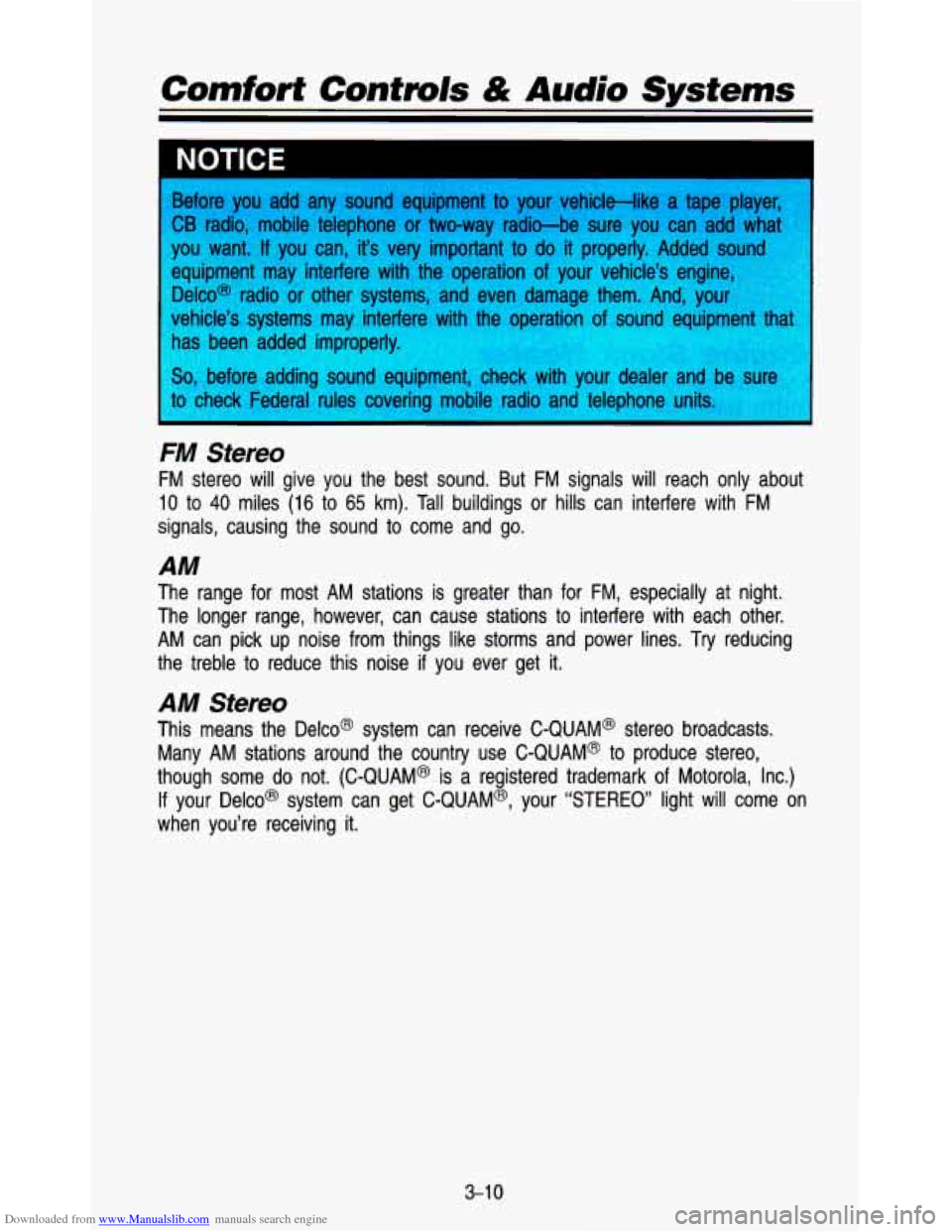
Downloaded from www.Manualslib.com manuals search engine Comfort Confmls & Audio Systems
NOTICE
Before you add any sound equipment
CB radio, mobile telephone or two-wa)
you want.
If you can, it’s very important to do
equipment may interfere with the operation of
Delco@ radio or other systems, and even damagt
I. And,
vehicle’s systems may interfere with the. ‘operQtion
of sound t
has been added improp( I
2, before adding sound equipment, LI teck LVILI~ your dealer ancj u
1 tu check Federal rules covering mobile radio and telephone unit-
FM Stereo
FM stereo will give you the best sound. But FM signals will reac\
h only about
10 to 40 miles (16 to 65 km). Tall buildings or hills can interfere with FM
signals, causing the sound to come and go.
AM
The range for most AM stations is greater than for FM, especi\
ally at night.
The longer range, however, can cause stations to interfere with\
each other.
AM can pick up noise from things like storms and power lines. Try reducing
the treble to reduce this noise
if you ever get it.
AM Stereo
This means the Delco@ system can receive C-QUAM@ stereo broadca\
sts.
Many AM stations around the country use
C-QUAM@ to produce stereo,
though some do not.
(C-QUAM@ is a re istered trademark of Motorola, Inc.)
If your Delco@ system can get C-QUAM’, 8 your “STEREO” light will come on
when you’re receiving it.
3-1 0
Page 153 of 345
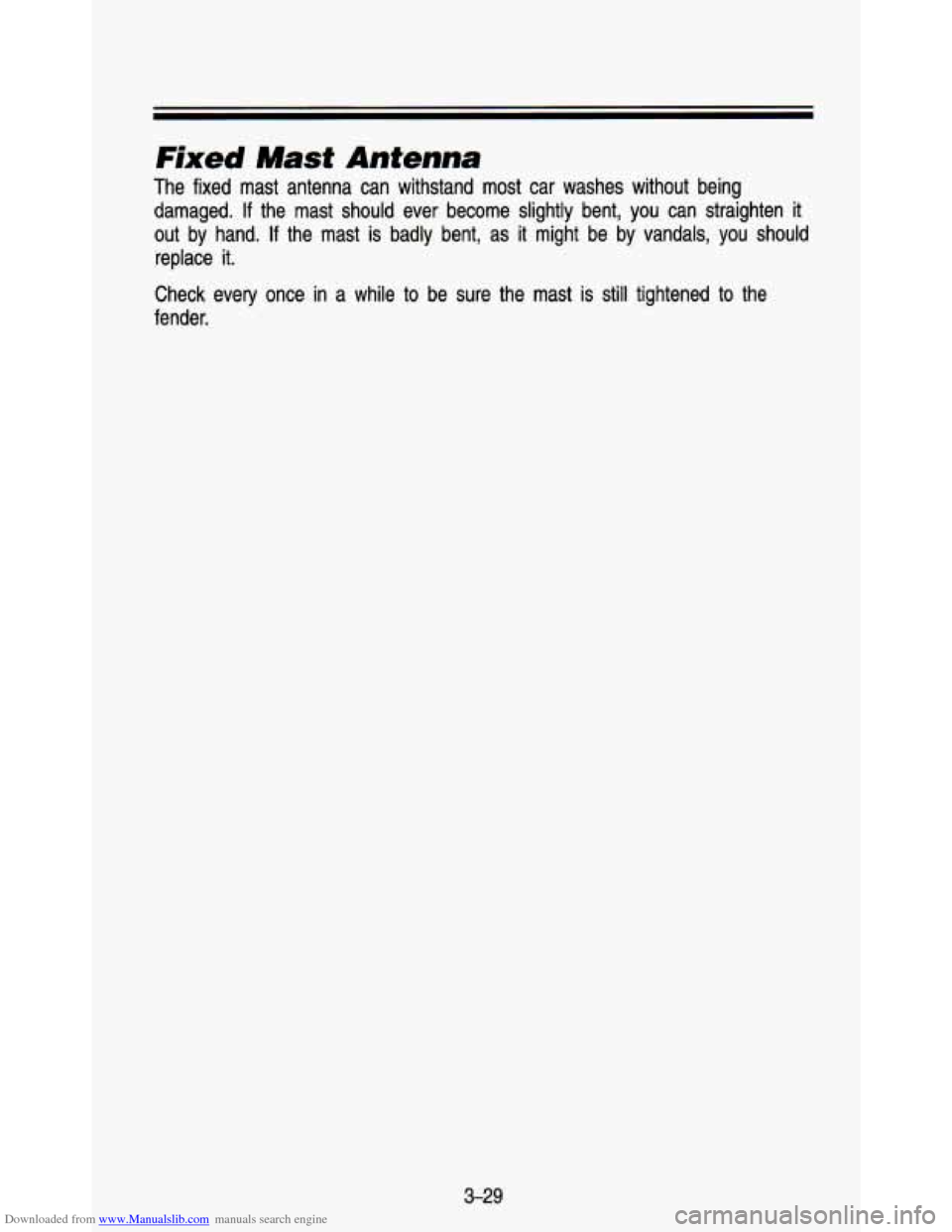
Downloaded from www.Manualslib.com manuals search engine Fixed Mast Antenna
The fixed mast antenna can withstand most car washes without b\
eing damaged.
If the mast should ever become slightly bent, you can straighten \
it
out by hand.
If the mast is badly bent, as it might be by vandals, you shoul\
d
replace
it.
Check every once in a while to be sure the mast is still tightened to the
fender.
3-29
Page 176 of 345
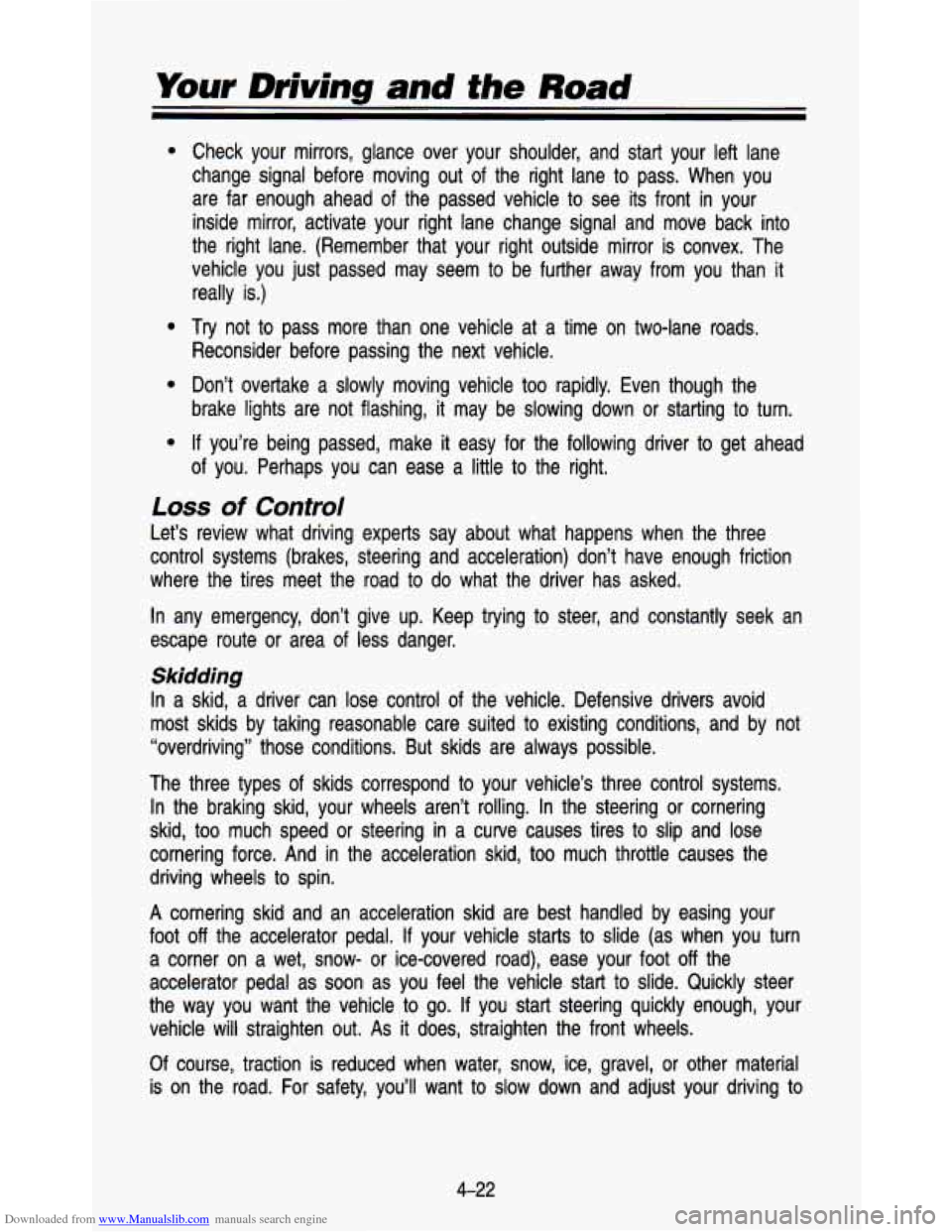
Downloaded from www.Manualslib.com manuals search engine Your Driving and the Road
0
Check your mirrors, glance over your shoulder, and start your \
left lane
change signal before moving out of the right lane
to pass. When you
are far enough ahead of the passed vehicle
to see its front in your
inside mirror, activate your right lane change signal and move \
back into
the right lane. (Remember that your right outside mirror is c\
onvex. The
vehicle you just passed may seem
to be further away from you than it
really
is.)
Try not to pass more than one vehicle at a time on two-lane roads.
Reconsider before passing the next vehicle.
Don’t overtake a slowly moving vehicle
too rapidly. Even though the
brake lights are not flashing, it may be slowing down or starting
to turn.
If you’re being passed, make it easy for the following driver
to get ahead
of you. Perhaps you can ease a little
to the right.
Loss of Control
Let’s review what driving experts say about what happens whe\
n the three
control systems (brakes, steering and acceleration) don’t ha\
ve enough friction
where the tires meet the road
to do what the driver has asked.
In any emergency, don’t give up. Keep trying
to steer, and constantly seek an
escape route or area of less danger.
Skidding
In a skid, a driver can lose control of the vehicle. Defensive drivers avoid
most skids by taking reasonable care suited to existing conditions, and by not
“overdriving” those conditions. But skids are always possib\
le.
The three types
of skids correspond to your vehicle’s three control systems.
In the braking skid, your wheels aren’t rolling. In the steering or cornering
skid,
too much speed or steering in a curve causes tires to slip and lose
cornering force. And in the acceleration skid,
too much throttle causes the
driving wheels
to spin.
A cornering skid and an acceleration skid are best handled by easing your
foot
off the accelerator pedal. If your vehicle starts to slide (as when you turn
a corner on a wet, snow- or ice-covered road), ease your foo\
t
off the
accelerator pedal
as soon as you feel the vehicle start to slide. Quickly steer
the way you want the vehicle
to go. If you start steering quickly enough, your
vehicle will straighten out.
As it does, straighten the front wheels.
Of course, traction is reduced when water, snow, ice, gravel, or other material
is on the road. For safety, you’ll want
to slow down and adjust your driving to
4-22
Page 179 of 345
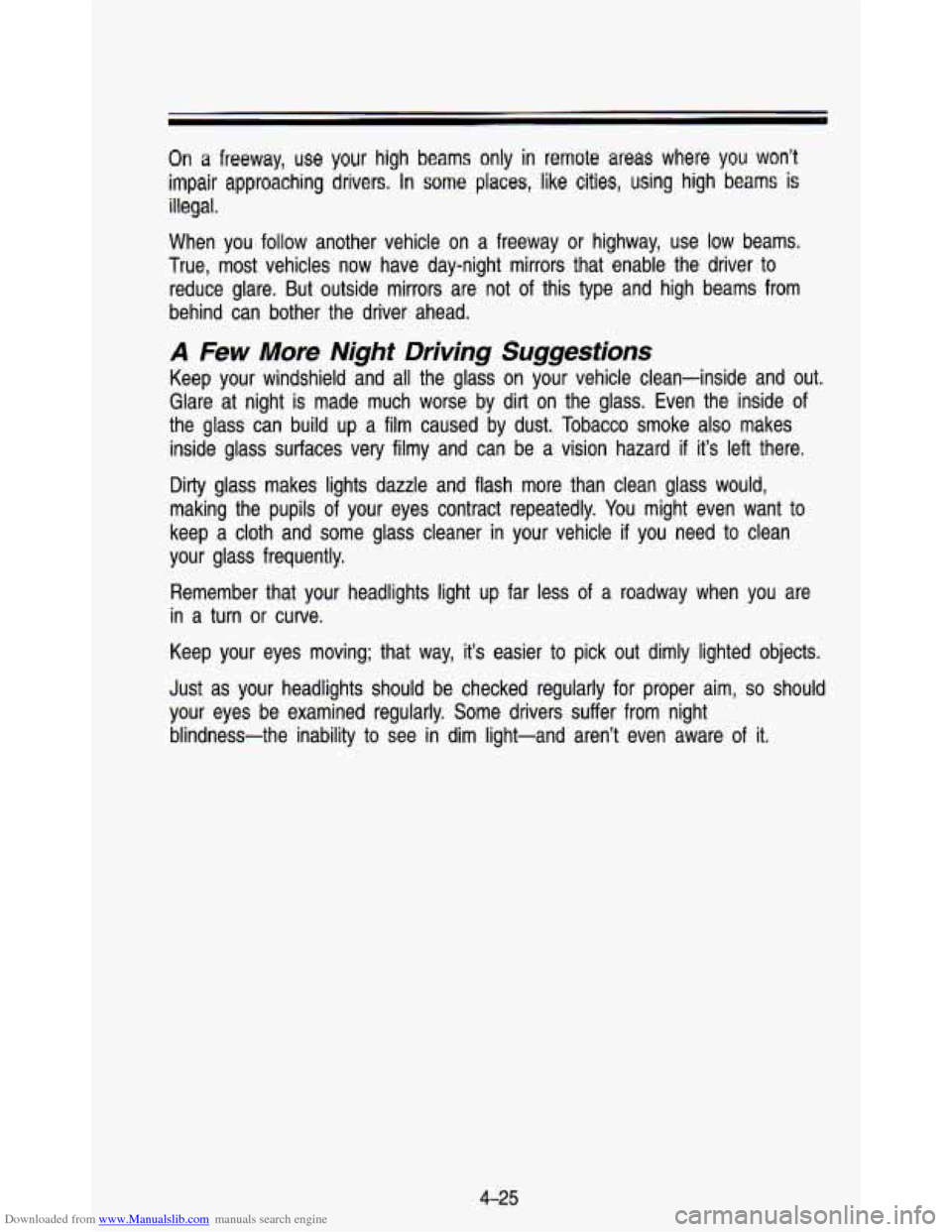
Downloaded from www.Manualslib.com manuals search engine On a freeway, use your high beams only in remote areas where you won’t
impair approaching drivers, In some places, like cities, using high beams is
illegal.
When you follow another vehicle on a freeway or highway, use
low beams.
True, most vehicles now have day-night mirrors that enable the \
driver to reduce glare. But outside mirrors are not of this type and hi\
gh beams from
behind can bother the driver ahead.
A Few More Night Driving Suggestions
Keep your windshield and all the glass on your vehicle clean-i\
nside and out.
Glare at night is made much worse by dirt on the glass. Even the inside
of
the glass can build up a film caused by dust. Tobacco smoke also makes
inside glass surfaces very filmy and can be a vision hazard
if it’s left there.
Dirty glass makes lights dazzle and flash more than clean glas\
s would,
making the pupils
of your eyes contract repeatedly. You might even want to
keep a cloth and some glass cleaner in your vehicle if you need to clean
your glass frequently.
Remember that your headlights light up far less of a roadway when you are
in a turn or curve.
Keep your eyes moving; that way, it’s easier to pick out dimly lighted objects.
Just as your headlights should be checked regularly for proper \
aim,
so should
your eyes be examined regularly. Some drivers suffer from night\
blindness-the inability to see in dim light-and aren’t even aware of it.
4-25
Page 184 of 345
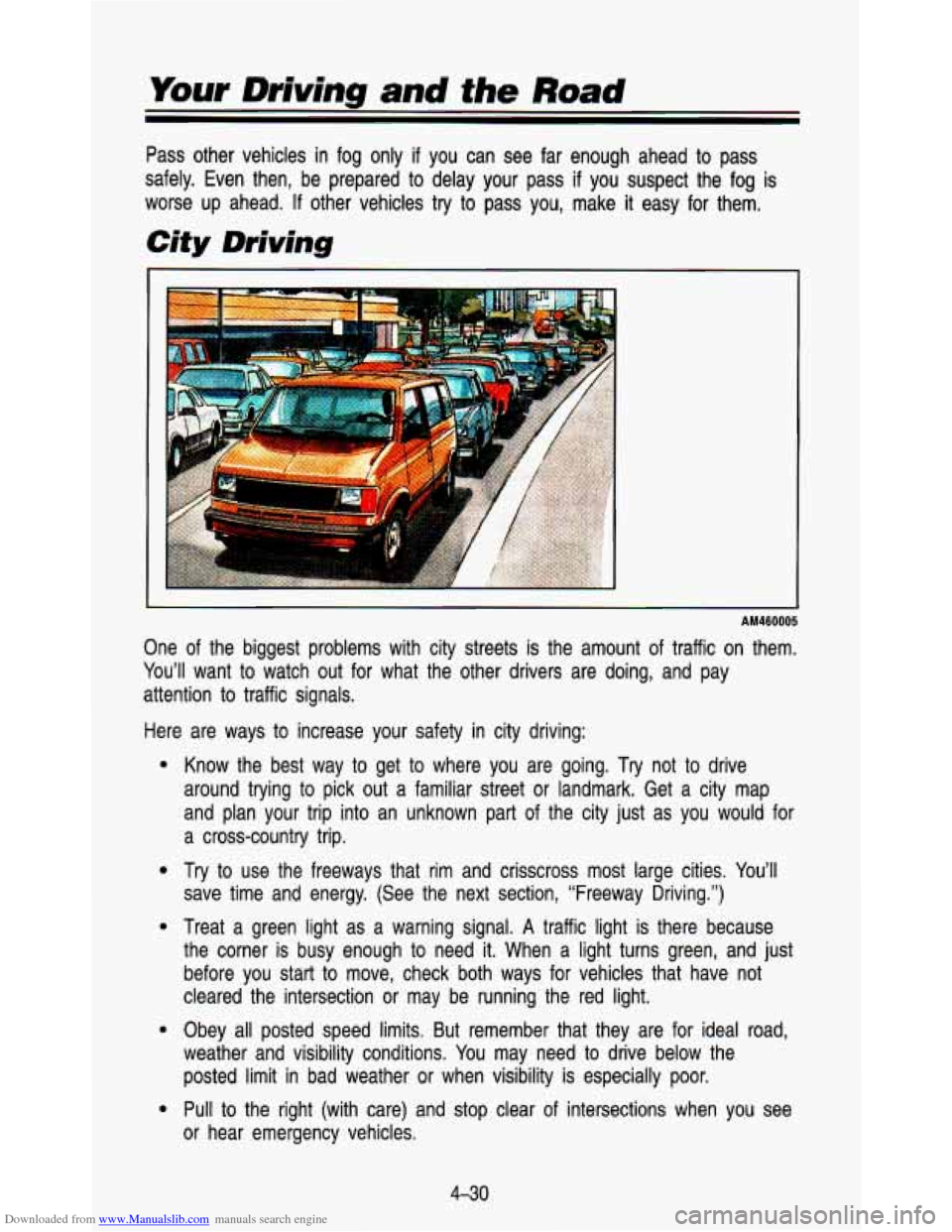
Downloaded from www.Manualslib.com manuals search engine Your Driving and the Road
Pass other vehicles in fog only if you can see far enough ahead to pass
safely. Even then, be prepared to delay your pass
if you suspect the fog is
worse up ahead.
If other vehicles try to pass you, make it easy for them.
City Driving
AM460005
One of the biggest problems with city streets is the amount of traffic on them.
You’ll want to watch out for what the other drivers are doing, and pay
attention to traffic signals.
Here are ways to increase your safety in city driving:
e
e
e
e
Know the best way to get to where you are going. Try not to drive
around trying to pick out a familiar street or landmark. Get \
a city map
and plan your trip into an unknown part of the city just as you would for
a cross-county trip.
Try to use the freeways that rim and crisscross most large cities. You’ll
save time and energy. (See the next section, “Freeway Drivi\
ng.”)
Treat a green light as a warning signal.
A traffic light is there because
the corner is busy enough to need
it. When a light turns green, and just
before you start to move, check both ways for vehicles that have not
cleared the intersection or may be running the red light.
Obey all posted speed limits. But remember that they are for ideal road,
weather and visibility conditions. You may need to drive below the
posted limit in bad weather
or when visibility is especially poor.
Pull to the right (with care) and stop clear of intersections when y\
ou see
or hear emergency vehicles.
430
Page 185 of 345
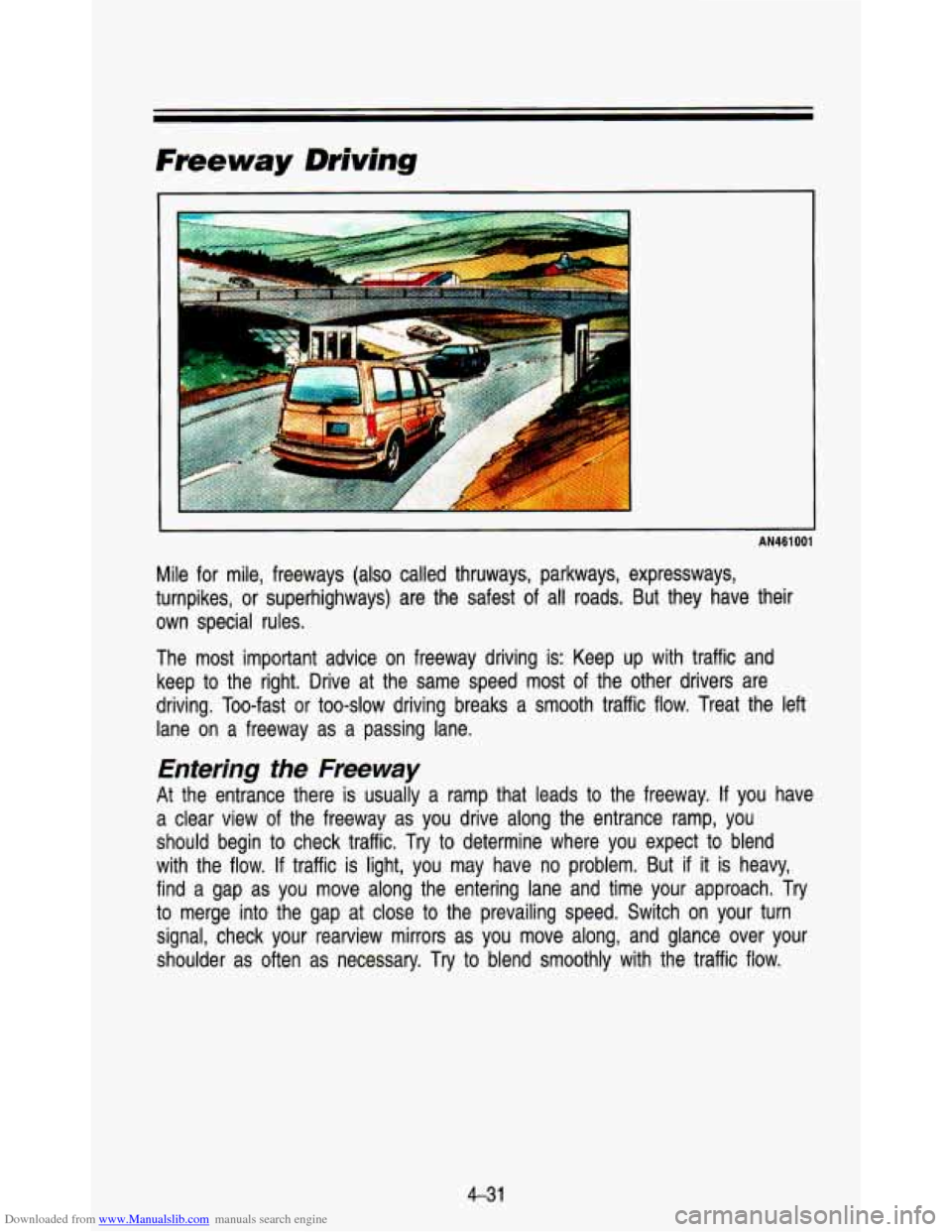
Downloaded from www.Manualslib.com manuals search engine Freeway Driving
I
P
AN461001
Mile for mile, freeways (also called thruways, parkways, expres\
sways,
turnpikes, or superhighways) are the safest of all roads. But they have their
own special rules.
The most important advice on freeway driving is: Keep up with \
traffic and
keep
to the right. Drive at the same speed most of the other drivers \
are
driving. Too-fast or too-slow driving breaks a smooth traffic
flow. Treat the left
lane on a freeway as a passing lane.
Entering the Freeway
At the entrance there is usually a ramp that leads to the freewa\
y. If you have
a clear view of the freeway as you drive along the entrance ramp, you
should begin to check traffic. Try to determine where you expect to blend
with the flow.
If traffic is light, you may have no problem. But if it is heavy,
find a gap as you move along the entering lane and time your\
approach. Try
to merge into the gap at close to the prevailing speed. Switc\
h on your turn
signal, check your rearview mirrors as you move along, and gla\
nce over your
shoulder as often as necessary.
Try to blend smoothly with the traffic flow.
4-31
Page 186 of 345
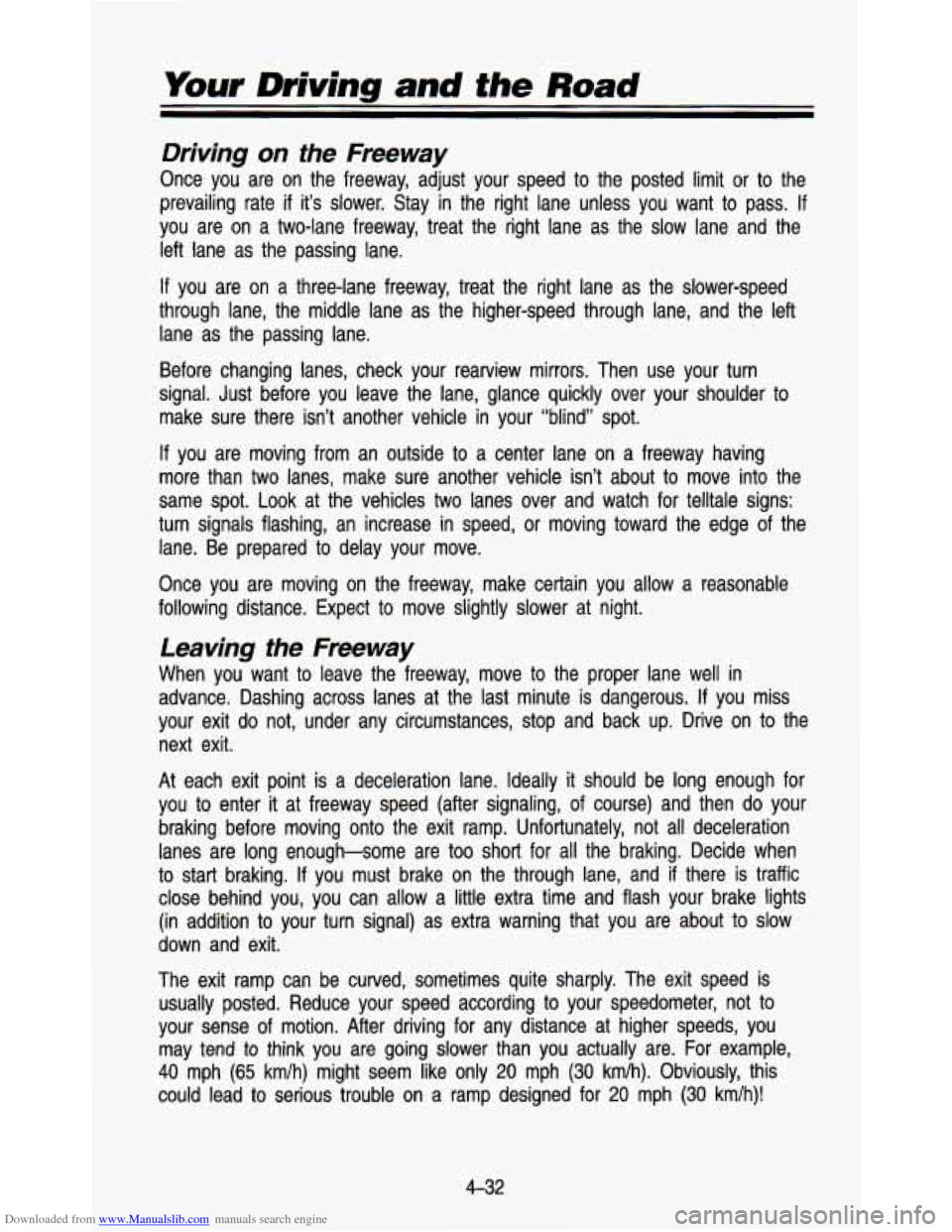
Downloaded from www.Manualslib.com manuals search engine Your Driving and the Road
Driving on the Freeway
Once you are on the freeway, adjust your speed to the posted \
limit or to the
prevailing rate
if it’s slower. Stay in the right lane unless you want to pass. If
you are on a two-lane freeway, treat the right lane as the s\
low lane and the
left lane as the passing lane.
If you are on a three-lane freeway, treat the right lane as the \
slower-speed
through lane, the middle lane as the higher-speed through lane,\
and the left lane as the passing lane.
Before changing lanes, check your rearview mirrors. Then use yo\
ur turn
signal. Just before you leave the lane, glance quickly over yo\
ur shoulder to make sure there isn’t another vehicle in your “blind” \
spot.
If you are moving from an outside to a center lane on a freeway\
having
more than two lanes, make sure another vehicle isn’t about \
to move into the
same spot. Look at the vehicles
two lanes over and watch for telltale signs:
turn signals flashing, an increase in speed, or moving toward \
the edge of the
lane. Be prepared to delay your move.
Once you are moving on the freeway, make certain you allow a \
reasonable
following distance. Expect to move slightly slower at night.
Leaving the Freeway
When you want to leave the freeway, move to the proper lane \
well in
advance. Dashing across lanes at the last minute is dangerous. \
If you miss
your exit do not, under any circumstances, stop and back up. \
Drive on to the
next exit.
At each exit point is a deceleration lane. Ideally
it should be long enough for
you to enter
it at freeway speed (after signaling, of course) and then do yo\
ur
braking before moving onto the exit ramp. Unfortunately, not al\
l deceleration
lanes are long enough-some are too short for all the braking. \
Decide when
to start braking.
If you must brake on the through lane, and if there is traffic
close behind you, you can allow a little extra time and flash\
your brake lights
(in addition to your turn signal) as extra warning that you \
are about
to slow
down and exit.
The exit ramp can be curved, sometimes quite sharply. The exit\
speed is usually posted. Reduce your speed according to your speedometer,\
not to
your sense of motion. After driving for any distance at higher\
speeds, you may tend
to think you are going slower than you actually are. For example,\
40 mph (65 km/h) might seem like only 20 mph (30 kmk). Obviously, this
could lead to serious trouble on
a ramp designed for 20 mph (30 kmlh)!
4-32
Page 187 of 345
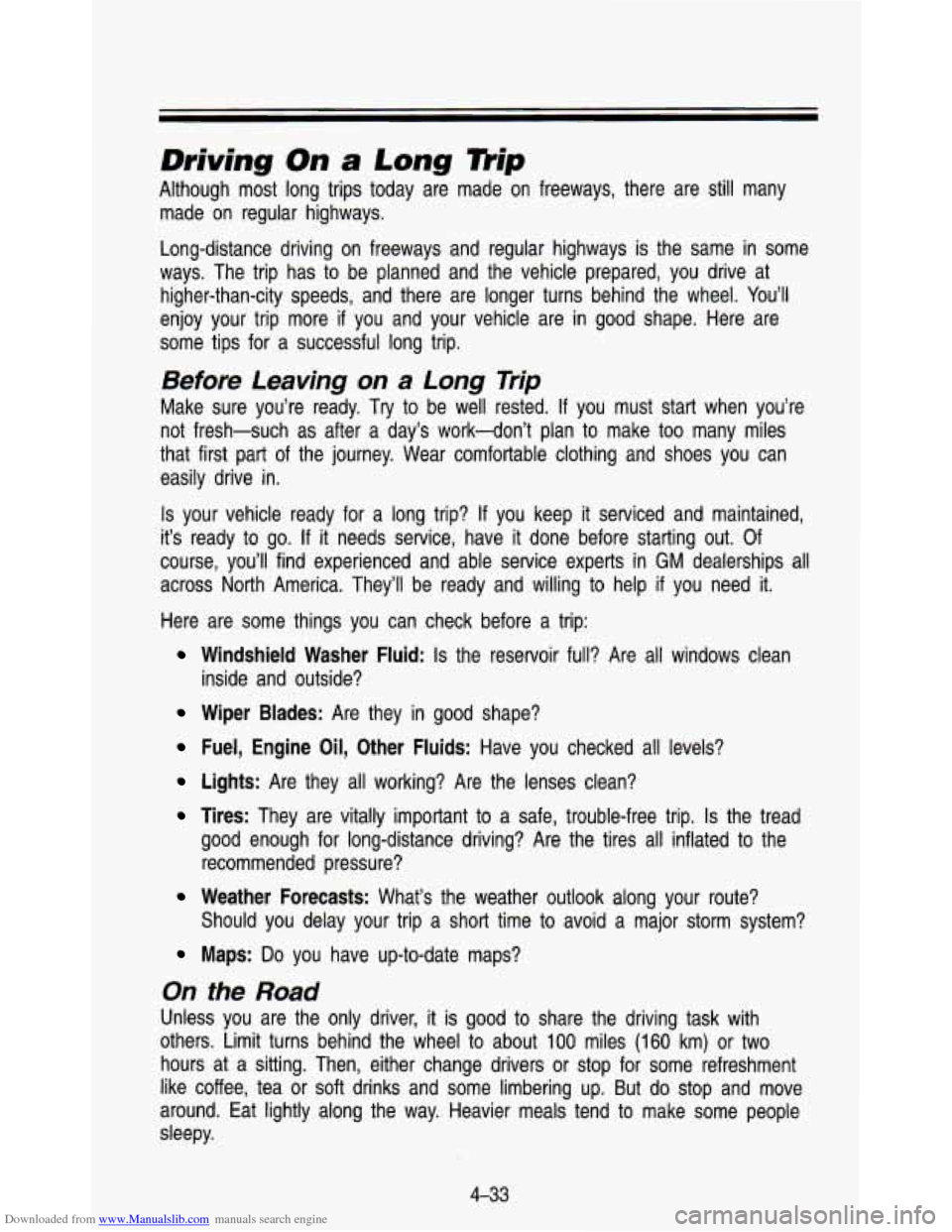
Downloaded from www.Manualslib.com manuals search engine Driving On a Long nip
Although most long trips today are made on freeways, there are still many
made on regular highways.
Long-distance driving on freeways and regular highways is the same in some
ways. The trip has to be planned and the vehicle prepared, you drive at
higher-than-city speeds, and there are longer turns behind the wheel. You’ll
enjoy your trip more
if you and your vehicle are in good shape. Here are
some tips for a successful long trip.
Before Leaving on a Long Trip
Make sure you’re ready. Try to be well rested. If you must start when you’re
not fresh-such as after a day’s work-don’t plan to make too many miles
that first part of the journey. Wear comfortable clothing and shoes you can
easily drive in.
Is your vehicle ready for a long trip? If you keep it serviced and maintained,
it’s ready to
go. If it needs service, have it done before starting out. Of
course, you’ll find experienced and able service experts in
GM dealerships all
across North America. They’ll be ready and willing to help
if you need it.
Here are some things you can check before a trip:
Windshield Washer Fluid: Is the reservoir full? Are all windows clean
Wiper Blades: Are they in good shape?
Fuel, Engine Oil, Other Fluids: Have you checked all levels?
Lights: Are they all working? Are the lenses clean?
Tires: They are vitally important to a safe, trouble-free trip. Is the tread
good enough for long-distance driving? Are the tires all inflated to the
recommended pressure?
Should you delay your trip a short time to avoid a major storm system?
inside and outside?
Weather Forecasts: What’s the weather outlook along your route?
Maps: Do you have up-to-date maps?
On the Road
Unless you
are the only driver, it is good to share the driving task with
others. Limit turns behind the wheel to about
100 miles (160 km) or two
hours- at a sitting. Then, either change drivers or stop for some refres\
hment
like coffee, tea or soft drinks and some limbering up. But
do stop and move
around. Eat lightly along the way. Heavier meals tend to make some people
sleepy.
4-33